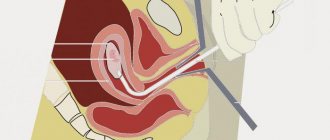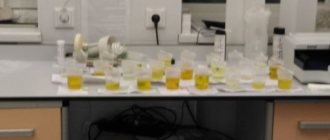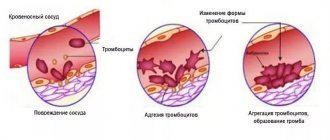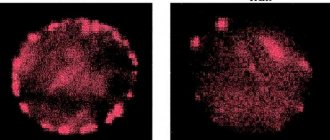Poor general blood test
A general (clinical) blood test is most often prescribed to patients.
Deviations of its values from the norm may indicate the development of diseases and pathologies in the body. Let's look at the main blood characteristics, changes in which indicate a poor general blood test.
1. Hemoglobin is a special blood protein that is responsible for transporting oxygen from the lungs to organs and tissues. A decrease in its level in the blood is very often the cause of poor blood tests during pregnancy. This deviation of the hemoglobin indicator from the norm indicates the development of anemia, which can lead to oxygen starvation of the expectant mother’s body. This is fraught with such serious consequences as delayed fetal development and premature birth. An increased concentration of hemoglobin in the blood occurs with congenital heart disease, blood thickening, intestinal obstruction, and erythrocytosis.
2.Red blood cells are red blood cells that carry oxygen in the body. Erythropenia (decreased red blood cell concentration) indicates iron deficiency anemia and blood loss. Erythrocytosis (increased red blood cell content) is a sign of dehydration, intestinal infections, pathologies of the lungs and hematopoietic system, heart disease, kidney and liver cancer.
3. Hematocrit - the ratio of the concentration of red blood cells in the body to the total volume of blood plasma. A decrease in its value may be the cause of a poor general blood test. In this case, it indicates anemia or overhydration. An increase in hematocrit occurs with dehydration of the body, congenital heart defects, erythremia, respiratory failure, and polycystic kidney disease.
4.Platelets are blood platelets that take part in the formation of blood clots. A decrease in their number indicates genetic diseases (May-Hegglin anomaly, Fanconi syndrome), megaloblastic anemia, adenoviruses, hepatitis, and malignant tumors. An increase in platelet levels is observed in myelofibrosis, erythremia, lymphogranulomatosis, lymphoma, liver cirrhosis, amyloidosis, rheumatoid arthritis, tuberculosis, and rheumatic fever.
5. Leukocytes are white blood cells responsible for the body's immune defense. Very often, a bad blood test occurs as a result of changes in this parameter. A decrease in the concentration of leukocytes indicates various pathologies and diseases (systemic lupus erythematosus, viral hepatitis, rubella, typhoid fever, malaria, brucellosis, influenza, measles, tuberculosis, malignant neoplasms). A high content of these cells in the blood accompanies leukemia, heart attack, otitis media, meningitis, bronchitis, and pneumonia.
6. Lymphocytes are a type of leukocyte that takes part in protecting the body from bacteria and viruses. A decrease in their level in the blood may be a sign of pneumonia, myocardial infarction, sepsis, or lymphoma. And their high concentration occurs in thyrotoxicosis and ARVI. In children, a high content of lymphocytes manifests itself in diseases such as mumps, chicken pox, scarlet fever, whooping cough, rubella, and measles.
7. Monocytes are immature blood cells, which, when they enter the human body, turn into macrophages (cells that destroy foreign particles, pathogens, dead cells). Decreased monocyte counts may be associated with anemia or hairy cell leukemia. And an increase in their concentration often indicates endocarditis, leukemia, lymphoma, tuberculosis, and sepsis.
8.Erythrocyte sedimentation rate (ESR) is an indicator that reflects the concentration of plasma proteins. When ESR increases, doctors talk about a bad blood test. A decrease in this indicator is observed in the case of overhydration and muscular dystrophy. One way or another, only a specialist can explain to the patient why the blood test is bad. Sometimes you need to donate blood again for testing.
Food for thought
Some facts about the disease:
The disease affects only men. This is not entirely true. There have been cases when the disease was diagnosed in representatives of the fair sex. There is an opinion that hemophilia is rarely diagnosed in women due to the physiological characteristics of the body. If a girl has poor blood clotting, menstrual bleeding can cause death.
- If a woman has the hemophilia gene, the child will be sick. In fact, women cannot plan for the birth of a sick or healthy child. This is only possible with artificial insemination and after special procedures. It is possible to determine whether a child has hemophilia or not only in the second month of pregnancy.
- Hemophilia and AIDS. In the 80s in the United States, after the advent of AIDS, it became clear that the pathology occurs not only among drug addicts or homosexuals, but also among those suffering from hemophilia. The virus was found in drugs used. It contained the blood of sick donors. A scandal broke out and pharmaceutical companies began producing safe, heat-treated medicine. But they didn’t take him outside the states. Residents of other countries continued to be sold spoiled drugs, as companies did not want to destroy drugs that were produced in large quantities. This would bring big losses. Therefore, the number of AIDS patients has increased.
Hemophilia is a serious disease, but you can live with it. There are even special organizations that unite people with this problem. In them, patients support each other and engage in various activities
It is important to remember: only by following the recommendations of specialists can you live a long life even with blood clotting disorders
Obviousness
Girls can only be carriers; only men can get sick.
Malfunctions in the functioning of the most important system of the body - the hemostasis system, designed to protect a person from blood loss - manifest themselves as a blood clotting disorder, that is, a pathology of coagulation of protein components of the blood in the event of bleeding.
The ability of blood to clot can be reduced for various reasons, leading to severe and fatal coagulopathies.
How to treat
Treatment of poor clotting is a long process. A full examination is required, on the basis of which the doctor prescribes a course of treatment. Most often, treatment measures include:
Elimination of vitamin K and calcium deficiency. Elimination of disorders associated with the functioning of platelets in the patient’s body. Donor blood transfusion. The use of medications for the normal functioning of fibrinogen. Eating foods high in vitamin K, calcium, and amino acids. First of all, these are dairy products (cottage cheese, kefir, sour cream, cheese, etc.)
It is important to focus on eating leafy vegetables (spinach, green onions, white cabbage), meat, and fish.
After consulting with a doctor, you can turn to traditional medicine. Doctors recommend drinking decoctions of nettle, yarrow, and pine nut shells. Black currant leaves, arnica, and barberry fruits will also help.
As a result, bleeding disorders are a serious problem. In each specific case, a complete and comprehensive examination gives a clear picture of the disease. Based on this, the doctor draws up a course of treatment.
Blood is the life-supporting internal environment of the body. It performs many functions: delivery of oxygen and nutrients; removal of decomposition products; regulation of heat exchange; transport of active enzymes and hormonal substances; protective function in the form of phagocytosis and hemostasis. But what to do if it’s bad, what could be the consequences and causes of such a pathology.
In a severe form of disorder of the coagulation system - von Willebrand disease, characteristic subcutaneous hemorrhages are formed, hemorrhages into the periarticular bursa are frequent, and internal bleeding is possible. Von Willebrand disease is inherited, but there are also acquired forms. They often occur as a complication and can be provoked by rheumatoid diseases and some heart pathologies.
Poor blood clotting - what is it? Everything about hypertension
Have you been struggling with HYPERTENSION for many years without success?
Head of the Institute: “You will be amazed at how easy it is to cure hypertension by taking it every day...
Read more "
Poor blood clotting is a consequence of the development of internal diseases. If left untreated, it can lead to serious complications. Why? Because it is this process that determines how quickly the bleeding will stop.
If everything is in order with the body, the bleeding stops quite quickly. This usually takes a few minutes. A bleeding disorder can lead to large blood loss, hemorrhage into the cavity of internal organs or under the skin.
Why do disorders appear (and blood clotting especially)? What to do in this situation?
Diagnosis and symptoms
You can find out whether blood clotting is bad or good if you donate blood for a biochemical analysis. It is called a coagulogram.
Symptoms of poor blood clotting can be diagnosed using other methods:
- assessment of the ability of platelets to stick together;
- analysis of bleeding duration.
Seeing a doctor is necessary after symptoms of low blood clotting appear:
- Small or, conversely, extensive hematomas appear on the skin. They are usually caused by internal hemorrhages.
- Nosebleeds.
- Frequent bleeding in the mucous membranes of the mouth and nasal cavity, as well as the intestines. In the latter case, blood may appear in the stool.
- Brain hemorrhages.
- In case of injury, such as cuts, it takes longer than usual for the blood to stop bleeding.
- Hemorrhages began to occur in muscles, joints and even internal organs. This condition manifests itself in bruises that appear even with slight pressure on the skin.
If you notice at least one of the above symptoms, you should immediately consult a doctor. Ignoring such violations can lead to serious consequences, including joint pain, bleeding in the gastrointestinal tract and in the brain.
What are INR and PTI and how to control them
PTI is the prothrombin index, it shows how well the blood clots. In a healthy person it should be in the range of 70-100, and for adequate protection against stroke while taking warfarin it should be 24.0-42.6.
If the PTI is less, there is a risk of bleeding, and if it is more, the risk of stroke increases. There are many different methods for determining this indicator: according to Quick, according to Tugolukov, so if you donate blood in different laboratories, the results will vary greatly.
But sometimes the fate of the patient depends on this difference.
Therefore, PTI is not used abroad at all, since there is another more stable indicator of the INR - the international normalization ratio. The results of this analysis will not differ much in whichever laboratory in whichever country in the world you perform it.
The target INR level should be 2-3; if it is less, then prevention will not be effective; if it is more, then the risk of serious bleeding will exceed the benefit of prevented strokes. Hundreds of thousands of people around the world have taken part in studies to clarify this middle ground.
For each patient, the dose of warfarin should be selected individually, preferably in a hospital setting. For this, 7-10 days are usually enough. Then the analysis is done after 2 weeks, if everything is in order - again after a month, and then once every three months.
If the indicators are outside the target level, then a dose adjustment is made. You can learn to do this on your own, but it is always safer to consult a doctor after the next INR analysis.
In addition, for the accuracy of the results it is very important to fulfill a number of conditions:
- Always take warfarin at the same time, such as 5:00 p.m.
- Always go to donate blood for INR, and even more so for IPT, to the same laboratory.
- Donate blood at the same time, if you go for the test for the first time at 9:00, then the next time try to get to the laboratory at least from 7:00 to 10:00.
Possible complications
If the causes of low blood clotting are discovered, it is necessary to begin treatment as quickly as possible, since this is the only way to get good results. If this is not done in time, the following complications may occur:
- Bleeding in the gastrointestinal tract;
- Bleeding in the brain;
- Severe pain and bleeding in the joints.
If a person is found to have poor blood clotting causes, treatment may vary, but therapy should be started as quickly as possible. After all, this pathology is very dangerous to human health and sometimes even fatal. At the first symptoms, the patient should immediately contact a specialist to avoid serious problems.
Causes of bleeding disorders
A life-threatening condition such as a bleeding disorder can occur as a result of exposure to external factors or be inherited. Hereditary pathologies include von Willebrand disease and hemophilia. These diseases most often manifest themselves in childhood with hemorrhage in the joints. Hemophilia is predominantly a male disease, while von Willebrand disease can affect both men and women: with this pathology, bruises (hematomas) appear throughout the body.
Bleeding disorders can also occur as a result of:
blood transfusions;
use of certain medications;
autoimmune diseases;
problems with clotting in small blood vessels;
liver diseases;
lack of vitamin K in the presence of a parallel malabsorption of lipids.
What are the dangers of blood clotting disorders?
In addition to the appearance of multiple bruises on the body that resemble a small rash, blood clotting pathologies can cause severe bleeding, which is quite difficult to stop. Also, the presence of problems with coagulation may be indicated by bleeding gums and the development of extensive hematomas, even in the case of a minor bruise. People suffering from this pathological condition are at real risk of thrombosis in the vessels and the development of strokes and heart attacks against them.
How do you know if you have a bleeding disorder?
In order to determine whether the blood coagulation process is normal, you need to take a test of the same name - a coagulogram, which involves directly taking blood from the patient and examining the resulting material using special equipment. Blood clotting is determined without fail if the patient is planning to undergo surgery, for women during pregnancy and in other situations that carry the risk of significant blood loss.
During the process of blood clotting, a special protein is formed - fibrin. This substance helps the body form blood clots, thickening the blood and is the body's natural response to blood loss. If this process is disrupted, prolonged, difficult-to-stop bleeding may develop, or, conversely, a hypercoagulation process, when the process of blood clotting occurs at an accelerated rate and threatens massive thrombus formation.
How to take a coagulogram
When visiting a doctor to determine blood clotting, a coagulogram will be prescribed. This laboratory test must be carried out on an empty stomach, blood is drawn from a vein, so you can do without the use of venous tourniquets and other unpleasant aspects. You need to try to calm down in advance and not be particularly nervous, relax as much as possible, in order to simplify the process of collecting material for both the specialist and yourself. It is also worth remembering that the accuracy of the result largely depends on compliance with preparation.
Before taking the test, it is forbidden to eat; at least 8 hours must pass from the last meal to the moment of blood donation. Also, you should not drink tea or juice in the morning; you can drink a glass of plain water. It is strictly not recommended to drink alcohol two days before taking a coagulogram.
What to do if you have bleeding disorders
If you notice bruises that have arisen for no apparent reason, you should immediately consult a specialist for advice. If bleeding begins, then you need to take a position in which the area with the wound should be higher than the rest of the body. The bleeding area must be clamped with a bandage or gauze. You also need to call an ambulance immediately.
If problems with blood coagulation are detected, the specialist will prescribe appropriate pharmaceutical therapy. The patient will also be prescribed an appropriate diet, which depends on the study indicators; accordingly, certain foods will have to be added or excluded. For example, garlic, sunflower seeds, chocolate, coffee, lemons, and beets have a thinning effect on the blood. Cilantro, buckwheat, rose hips, and walnuts have the opposite (thickening) effect.
Poor blood clotting
The viscosity of a biological substance affects its ability to perform a trophic function in the body. External or internal damage to the vessel wall serves as a trigger for a further rapid coagulation process. Poor blood clotting prevents the normal supply of nutrients and oxygen to cells, which provokes the development of many serious diseases.
Symptoms
Poor nutrient fluid coagulation rates pose a direct threat to the patient's life. In this regard, a test for the coagulability of a biological substance must be taken before any procedure that involves even minimal blood loss. A coagulogram must also be taken before taking medications that dilute biological fluid. Patients with poor blood clotting may experience the following signs of this disease:
- spontaneous bleeding;
- formation of hematomas even from minor bruises;
- weakness, dizziness.
Causes
A decrease in the coagulability of a biofluid is not as common as an increase. Many factors contribute to the occurrence of dangerously low degrees of coagulation. An integrated approach to studying the problem helps to find out the causes of poor blood clotting. The main reasons for the body’s reduced reaction to the outpouring of the “red substance” are the following human conditions:
- Liver diseases that complicate the synthesis of many clotting factors.
- Acute loss of body fluids; leads to the loss of its formed elements.
- Decrease in the mass fraction of platelets.
- Lack of vitamin K, which is involved in the synthesis of prothrombin.
- Hemophilia.
- The last stage of DIC syndrome, which occurs against the background of sepsis and soft tissue abscess.
What to do if blood doesn't clot well
If you have the symptoms listed above, you should definitely consult a doctor and undergo an examination. At the moment of bleeding itself, first aid should be provided in accordance with general recommendations, based on the location and type of injury. If necessary, call an ambulance.
Diagnostics
To diagnose blood clotting, the doctor first reviews the patient's medical history. To do this, he will ask questions about your health problems and medications you are taking. You need to answer something like this list of questions:
- What are the accompanying symptoms?
- How often does bleeding occur?
- How long does the bleeding last?
- What were you doing before the bleeding started (for example, were you sick, took medications)?
Basic tests to check blood clotting
- A complete blood count to check the blood loss at the time the test was taken and the number of red and white blood cells.
- Platelet aggregation test, which shows the extent to which platelets are able to adhere to each other.
- Measuring bleeding time to see how quickly blood vessels clog after pricking a finger with a feather.
Treatment options for poor blood clotting
Treatment for a bleeding disorder is based on the causes that cause it. If possible, the diseases that caused the disorder, such as cancer or liver disease, are immediately treated. Additional treatments include:
- Taking vitamin K by injection;
- Drugs aimed at improving clotting function;
- Transfusion of frozen donor blood plasma or donor platelets;
- Other drugs, including hydroxyurea (Droxia, Hydrea), and oprelvequin (Neumega) to treat platelet-related disorders.
Treatment of consequences caused by blood loss
Iron supplements
If there is significant blood loss, the doctor may prescribe medications containing iron to replenish its amount in the body. Low iron levels can lead to iron deficiency anemia, which is accompanied by feelings of weakness, shortness of breath and dizziness. One of the most common and accessible drugs in this case is Hematogen. In addition to treatment with iron supplements, blood transfusions may be required.
Blood transfusion
During this procedure, as most people know, blood loss is compensated with the help of donor blood. Donated blood must match your blood type to prevent complications. This procedure can only be performed in a hospital.
Complications of bleeding disorders
The best treatment results can be achieved if treatment is started as early as possible. Complications can occur if it is started too late or after heavy bleeding.
Common complications of bleeding disorders:
- bleeding in the brain;
- bleeding in the gastrointestinal tract;
- bleeding and joint pain.
How to improve blood circulation and raise Qi?
Treatment methods
Acupuncture will help improve blood circulation and with the help of channels, blood vessels will be treated, as well as Qi will rise.
A medicine made from natural herbs will help improve blood circulation and get rid of pain in the shoulder, neck, head, kidneys, nerves and improve their performance; sometimes these organs, vessels, membranes hurt due to lack of blood, slow blood circulation, decreased Qi.
Bloodletting - will help get rid of blood clot and stagnation, after clearing toxins, blood circulation and fresh, clean blood immediately follows. At the very first session, the pain already goes away and the muscles feel relaxed.
If after the first procedure you feel better and you are already thinking “I have recovered and I don’t need to come,” then you are deeply mistaken! You will not be able to recover completely from the first procedure and immediately interrupting treatment would also be a huge mistake! Only a doctor can prescribe treatment, only a doctor can determine a disease, only a doctor can tell you how much treatment you need to do, so if you want to have healthy health, then you should listen to the doctor and fight for your health together with him.
Norms and dangerous symptoms
Clotting ability is studied using a variety of tests that will require both venous and capillary blood.
The most complete analysis is considered to be a coagulogram, which allows a step-by-step assessment of the blood clotting process from beginning to end, identifying the “place” and cause of the failure.
Data from such an analysis have great diagnostic value and allow a specialist to accurately determine the pathology, understand what to do, and prescribe the most effective treatment.
Blood clotting tests are prescribed for patients with suspected liver disease, autoimmune pathologies, varicose veins or other similar diseases of the cardiovascular system.
Symptoms indicating problems with blood clotting include:
For the purpose of prevention, tests on the properties of blood are always carried out before major surgical interventions, after operations and for women during pregnancy.
Coagulation tests primarily evaluate:
How to diagnose the disease?
To identify the causes of pathology and select highly effective treatment, the patient must undergo an examination, which includes:
- Comprehensive blood test. This test determines how many white and red blood cells are in the blood;
- Platelet aggregation assay. This study will make it possible to understand whether platelets can attach to each other;
- Determination of bleeding duration. This study shows how long it takes for the blood vessels to become blocked after puncture of the skin surface.
Symptoms of poor clotting
In some diseases, they may be completely absent or present in too low quantities. Based on the above, the causes of poor blood clotting can be divided into inherited (passed on by genetics) and acquired.
Clotting factors II, V, VII, X, XII – cause blood clotting problems or abnormal bleeding. The main sign of a bleeding disorder is bleeding that lasts a long time or is too heavy. The bleeding is usually heavier than usual and for no obvious reason. To diagnose blood clotting, the doctor first reviews the patient's medical history.
A stroke can be life-threatening and may require immediate medical attention. If you are allergic to apixaban or any of the other ingredients of this medicine. If you have an organ disease that increases your risk of heavy bleeding.
Treatment of consequences caused by blood loss
If you have a liver disease that increases your risk of bleeding. If you are taking medications that do not allow blood to coagulate, if you are not changing your anticoagulant therapy, or if you do not have a venous or arterial catheter and heparin is allowed through this catheter to maintain its permeability.
Other drugs, including hydroxyurea (Droxia, Hydrea), and oprelvequin (Neumega) to treat platelet-related disorders. If there is significant blood loss, the doctor may prescribe medications containing iron to replenish its amount in the body. One of the most common and accessible drugs in this case is Hematogen. During this procedure, as most people know, blood loss is compensated with the help of donor blood.
Warnings and Precautions. Tell your doctor before taking this medicine if you have any of the following
Increased risk of bleeding, for example. Blood clotting disorders, including conditions that reduce platelet activity.
Very high blood pressure that is not controlled by medication. Severe kidney disease or if you have problems with dialysis. Liver failure or previous liver failure. If you need surgical procedures or procedures that may cause bleeding, your doctor may ask you to temporarily stop using this medication for a short time. If you are unsure whether the procedure may cause bleeding, consult your doctor.
The blood coagulation system is a very complex enzymatic system, multi-stage and diverse. There are also other blood clotting factors; non-protein components (for example, calcium ions) also participate in this system.
Talk to your doctor, pharmacist or nurse if you are taking or have recently taken any other medicines, or if you are unsure. Some medications may increase the effect of Eliquis, while other medications may make it less effective. Your doctor will decide whether you should take Eliquis while taking these medications and how closely your condition should be monitored.
Some medications to treat fungal infections. Other medications used to reduce blood coagulation. Anti-inflammatory or pain medications. In particular, if you are over 75 years of age and take aspirin, you may have an increased risk of bleeding.
Treatment of the disease
In the event that the disease arose due to any systemic pathology that caused a decrease in the rate of blood clotting, then treatment should be aimed at eliminating the underlying causes of the disease. Thus, when the underlying disease is leukemia, patients are prescribed radiation along with chemotherapy, and, if necessary, bone marrow transplantation.
When the liver is to blame for the blood not clotting, patients are prescribed drug treatment using hepatoprotective drugs. Often, remission of the disease is achieved by enriching the nutritional diet with essential components, the deficiency of which led to the development of pathology. For this, patients are prescribed folic acid, calcium, vitamin K, and in addition, essential amino acids. It is possible to increase blood clotting in a child or adult who suffers from an illness through the use of certain medications.
Poor blood clotting, what is the name of the disease?
Poor blood clotting, as well as its thickening, are not a disease, they are a manifestation of diseases and conditions that determine a decrease in the concentration of coagulation factors in the blood. Diseases are often hereditary.
- Hemophilia. Genetically determined disease. There are two types - when there is no protein in the blood responsible for blood clotting or when there is a deficiency of Christmas plasma.
- Von Willebrand's disease. In most cases, hereditary deficiency of specific von Willebrand factor in the blood of patients. As a result, a blood clot does not form, since platelets do not stick to the walls of the damaged vessel, and aggregation of blood platelets does not occur. A decrease in von Willebrand factor in the blood also occurs as a result of multiple blood transfusions, aortic stenosis, and rheumatoid arthritis.
These are two diseases, the main manifestation of which is increased bleeding. You can also note conditions associated with the number of blood cells that take part in the formation of a blood clot - a thrombus at the site of damage to a vessel or fibrin threads fixing it:
- thrombocytopenia;
- fibrinopenia.
Symptoms: how blood pathologies manifest themselves
The symptomatology of blood diseases differs depending on the affected blood component.
In the case of red blood cell disease, symptoms are often associated with a deficiency of oxygen and hemoglobin:
- pallor
- asthenia
- feeling cold
Platelet pathologies may manifest themselves:
- the appearance of spots on the skin that look like bruises, or bleeding for no reason when the platelet count becomes too low.
- the formation of blood clots and clots when the platelet count is excessive.
In the presence of pathologies, spasms may manifest themselves:
- blood clotting difficulties
- bleeding
How to make a diagnosis
First, the doctor questions the patient about complaints and examines him. If the disease is present, the joints are deformed and during exacerbations of the disease they hurt greatly. Muscle atrophy is observed around the affected joints, and the limbs are thin. The patient's body is usually covered with hematomas of various sizes and pinpoint hemorrhages.
Superficial thrombophlebitis is an uncomfortable condition but rarely causes serious problems. Sometimes thrombophlebitis is caused by a bacterial infection in a vein. In some cases, thrombophlebitis develops without an obvious reason. It can develop in the leg veins of pregnant women, in people with varicose veins, and in some people with abdominal cancer. Women over 35 who smoke and take oral contraceptives are at higher risk of developing blood clots.
Long sessions of sitting or bed rest or traumatic drugs such as estrogen and birth control pills with higher levels of estrogen damage by feet or hospital immobilization and cancer-related infection. The flow of blood in the veins is dependent on the contraction of surrounding muscles and with inactivity such as extended bed rest, blood begins to pool and blood clots can easily form.
If a pathology is suspected, patients with hemophilia undergo the following diagnostic examinations:
- Blood clotting time and bleeding duration are determined. If everything is fine with the hematopoietic system, then the blood clots in ten minutes.
- Prothrombin and activated partial thromboplastin times are determined. In the case of hemophilia, it is lengthened.
- The amount of coagulation factors is calculated.
Additionally, an examination of the affected joints and tissues is carried out. For this purpose, an x-ray is prescribed.
Poor analysis results due to improper preparation
Having received a referral from a specialist for a study, the patient needs to find out how to properly prepare for it. Let's look at the basic recommendations for donating blood. As a rule, all blood tests (biochemical studies, hormone tests) are taken in the morning on an empty stomach (8-10 hours after eating). It is also sometimes recommended to take a general blood test on an empty stomach, but often it is enough to maintain a 3-hour interval between the last meal and this procedure.
The day before the test, you must refrain from eating fatty, spicy, salty, sweet, fried foods, as well as alcoholic beverages. In addition, you should not visit a bathhouse, sauna, or engage in excessive physical activity before this procedure.
Smoking is prohibited 2 hours before the test, and it is advisable to sit quietly for 15-20 minutes before donating blood. At this time, a person can drink clean water. In some cases, a poor test result, especially a poor blood test during pregnancy, may be the result of extreme anxiety or fast walking.










